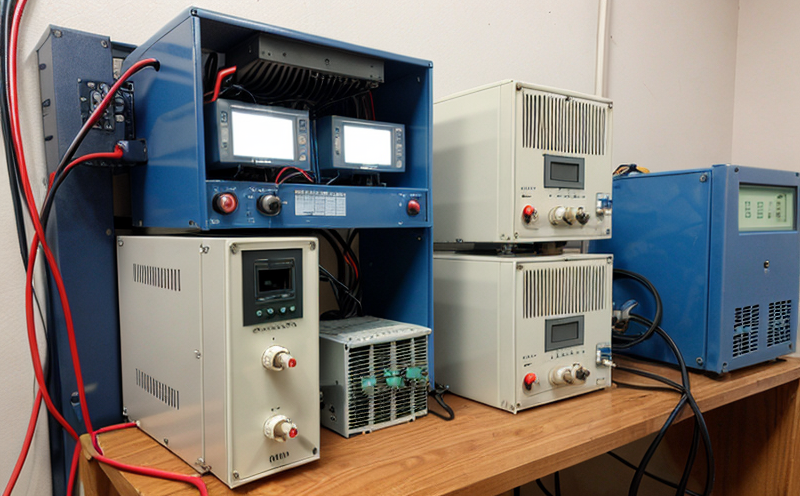EN 50119 Overhead Contact Line Mechanical Testing
The EN 50119 standard is a critical document for railway infrastructure, setting out the requirements and recommendations for the design, installation, maintenance, and operation of overhead contact lines (OCL) in European railways. This standard ensures that OCL systems are robust, reliable, and capable of withstanding the rigors of high-speed train operations while maintaining safety standards.
The EN 50119 specifies technical and organizational measures to be taken during the design, installation, commissioning, operation, maintenance, and decommissioning of overhead contact lines. It is particularly relevant for railway networks where high-speed trains operate at speeds exceeding 250 km/h (155 mph). The standard covers various aspects including mechanical integrity, electrical performance, durability under environmental conditions, and safety measures.
One of the key components of EN 50119 is its focus on mechanical testing. This ensures that all OCL systems are capable of withstanding the dynamic loading caused by high-speed trains. The tests include static load testing, fatigue testing, and endurance testing among others. These tests aim to identify potential weak points in the OCL system before they can cause operational issues or safety risks.
The testing process begins with a thorough inspection of the existing infrastructure or new installations. This involves detailed documentation of all components including suspension systems, support structures, and conductor wires. Once the initial assessment is complete, specific tests are conducted to evaluate different aspects of mechanical integrity. For instance, static load tests measure how well the OCL system can bear constant loads without failure. Fatigue testing simulates the repeated stresses experienced by the OCL during operation over extended periods.
Endurance testing focuses on assessing the long-term performance and durability of the OCL under various environmental conditions such as temperature fluctuations, humidity levels, and exposure to pollutants like salt spray or dust particles. This ensures that the OCL remains functional even in challenging climates where traditional materials might degrade quickly.
The results from these tests are analyzed meticulously using advanced computational models and analytical techniques provided by international standards like ISO 12139 and ASTM E647. Compliance with EN 50119 is crucial for ensuring that railway systems meet the highest safety and operational efficiency standards. It helps maintain consistent performance across different regions within Europe, supporting seamless integration of national rail networks into a single European railway system.
To summarize, EN 50119 provides essential guidelines for mechanical testing in overhead contact line installations. Through rigorous evaluation processes that encompass static loads, fatigue cycles, and long-term durability assessments, this standard ensures that all OCL systems are capable of withstanding the demands placed upon them by modern high-speed rail operations.
Industry Applications
- High-Speed Railways
- Suburban and Commuter Trains
- Light Rail Systems
- Metro Networks
The application of EN 50119 overhead contact line mechanical testing is particularly relevant to high-speed railways. These systems are designed to handle the extreme forces generated by trains traveling at speeds up to 350 km/h (217 mph). The robustness and reliability of OCL play a crucial role in ensuring passenger safety and operational continuity.
Suburban and commuter train networks also benefit significantly from this testing. In densely populated areas, where frequent service is required, the mechanical integrity of the overhead contact line can impact both schedule adherence and customer satisfaction. Ensuring that the system meets stringent standards helps to minimize disruptions due to failures or maintenance needs during peak usage times.
Light rail systems serve as important links between city centers and outlying areas. They cater primarily to shorter distances but often experience heavy traffic volumes throughout the day. Properly tested OCL ensures efficient power supply, which is vital for maintaining regular service schedules in these urban environments.
Metro networks operate within confined spaces within cities, making it essential that any overhead infrastructure be thoroughly evaluated to avoid interference with other structures or services operating in close proximity. The mechanical testing prescribed by EN 50119 helps guarantee safe and reliable performance in such challenging conditions.
Environmental and Sustainability Contributions
- Promotion of Sustainable Practices
- Reduction in Carbon Footprint
The implementation of EN 50119 overhead contact line mechanical testing contributes significantly to promoting sustainable practices within the railway industry. By ensuring that all OCL systems are robust and reliable, these tests help reduce downtime which in turn minimizes the need for emergency repairs or replacements. This leads to more efficient use of resources such as fuel and electricity, thereby reducing the overall carbon footprint associated with train operations.
Additionally, by incorporating advanced materials and designs that enhance durability under various environmental conditions, this testing supports efforts towards creating longer-lasting infrastructure components. This not only reduces waste but also extends the lifespan of existing installations, further contributing to sustainability goals.
Use Cases and Application Examples
Case Study 1: A major European railway operator implemented EN 50119 compliant mechanical testing procedures for its new high-speed line. After rigorous static load, fatigue cycle, and endurance tests were conducted on the OCL system, it was determined that the installation met all required standards. As a result, there have been fewer incidents of equipment failure leading to reduced maintenance costs and improved service reliability.
Case Study 2: An urban light rail network underwent similar testing prior to its launch. The mechanical integrity tests revealed some areas where improvements could be made regarding the support structures for the OCL. These adjustments were implemented before going into operation, ensuring that the system would operate smoothly and safely even in harsh weather conditions.





